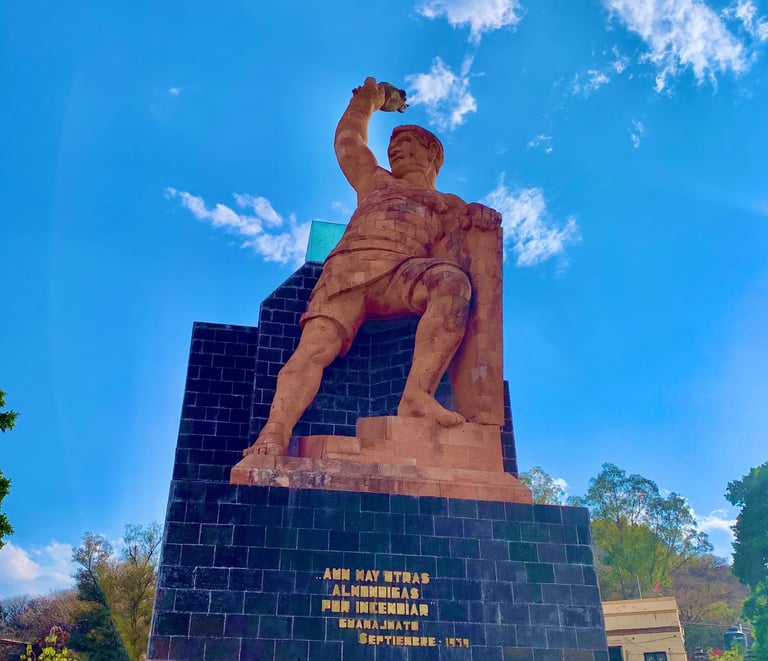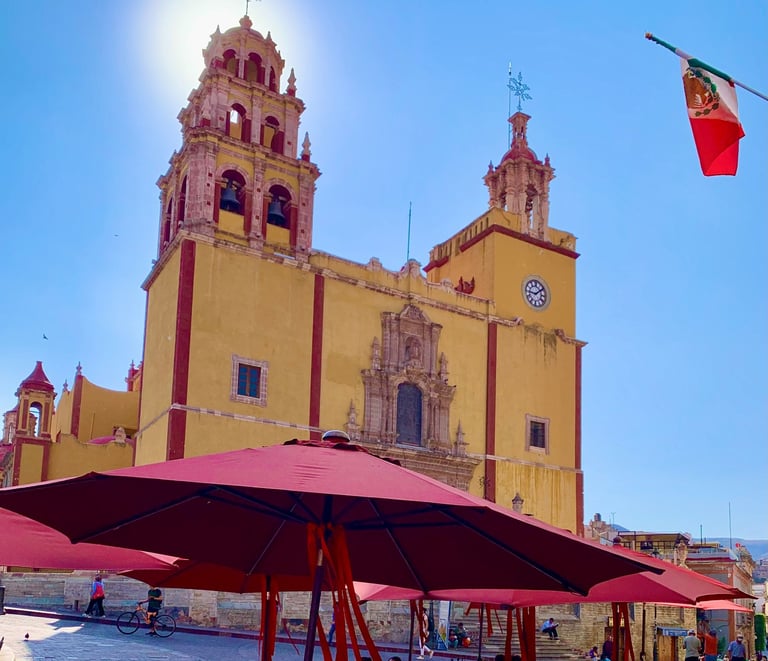Historical Significance of Guanajuato and El Pipila
GUANAJUATO, MEXICO


Guanajuato was founded by the Spanish in 1554, but long before the Spanish arrived, several Indigenous groups lived in the area. In fact, the name “Guanajuato” is derived from the Purepech word Quanax-juato or “Place of Frogs”. The Spanish used the sound of this Purepech word to translate it into their own version of “Guanajuato” which is the official name today. The Purepechas (also referred to as Tarascans), were only one of several distinct Indigenous groups living in and around the Guanajuato area.
However, the Spanish did not make much of an effort to distinguish among the diverse peoples and cultures living in the area. Instead, they used the term Chichimecas, a term used by the Aztecs to represent a wide range of nomadic and semi-nomadic Indigenous groups with distinct cultures and languages living throughout various parts of Mexico. The mainly nomadic groups occupying the Guanajuato area included the distinct Indigenous groups known as the Guachichiles, Guamares, Pames, and Otomies.
The Spanish often referred to the Chichimecas as being the most ferocious, the most brave and the most elusive of all their Indigenous adversaries in New Spain. In fact, the Spanish were unable to defeat the Chichimecas militarily, but by the end of the 16th century, the Spanish occupied most of the productive land and resources in the area. This allowed the Spanish to "negotiate" peace with the Chichimecas in exchange for basic goods such as blankets, clothes, and food.
After the Chichimecas were persuaded to settle down, there was a huge influx of Spaniards and other diverse Indigenous groups from many parts of Mexico, resulting in a high degree of assimilation. As the Chichimecas were gradually displaced, a new ethnic mix resulted in the loss of Indigenous culture and identity. The Spanish also imposed a rigid socio-racial classification system, called the Casta system, designed to maintain a strict social hierarchy based on ancestry. While the Casta system is no longer officially practiced in Mexico, it continues to offer an important lens to see its lasting impact and long shadow on contemporary Mexican society.
[Here is a link to a very informative article for more details on the Casta system.]
It was the discovery of vast amounts of silver beginning in the 16th century, and then again in the 18th century that put Guanajuato on the map for Spain. In fact, Guanajuato became the world’s leading silver mining center in the 18th century. Grand and opulent reminders of the city’s historic wealth from mining can be seen in its beautiful architecture featuring colonial buildings, cathedrals, theaters and monuments.
La Basilica of Guanajuato (top right) is perhaps the most emblematic building in the city, in a striking shade of ocher yellow, and located in the Plaza de la Paz (Plaza of Peace). Featuring a blend of baroque and neoclassical architectural styles, construction began in 1671 and was completed in 1696. Inside is a sacred wooden sculpture that was a gift from the King of Spain, King Philip II to the people of Guanajuato to recognize the vast quantities of silver that the local mines produced for the Spanish monarch.
The first major battle for Mexico’s independence took place in Guanajuato. On September 16, 1810, in the nearby town of Dolores, Miguel Hidalgo gave his famous call to arms that triggered the Mexican War of Independence, a revolt against Spanish colonial rule that lasted 10 years. On September 28, Hidalgo and his insurgent army arrived in Guanajuato City where royalist troops and many elite made a stand in the Alhondiga de Granaditas granary, a huge building with thick walls and few windows.
Royalist troops heavily defended the building with gunfire so Hidalgo and his insurgent army were unable to approach and penetrate the building. That is until a silver miner by the name of Juan José de los Reyes Martínez strapped a large flat stone to his back for protection and was able to reach the giant wooden doors to the granary and smeared them with tar and set them on fire. This allowed the insurgents to enter the building and defeat the royalist army and elite, taking over the heavily fortified building.
This was the first official victory of the Mexican War of Independence. Today, the man who set fire to the wooden doors has been commemorated as a hero by the huge statue of El Pípila (top left) that overlooks the city. The torch that El Pípila carries is known as the “torch of liberty,” and he has been given the best view in all of Guanajuato City.
According to local legend, El Pípila, or "The Turkey" translated into English, earned his nickname due to his physical appearance and mannerisms. Some accounts describe him as being stocky and having a protruding chest, resembling the shape of a turkey when he walked, which may have contributed to his ability to carry out his heroic act.
Despite its seemingly negative connotations, the name, El Pípila, carries profound respect and admiration for Juan José de los Reyes Martínez and his courageous actions.
Today in Mexico, Hidalgo’s call to arms is known as El Grito de Indepencia (The Independence Cry). Every year on the eve of Independence Day, the President of Mexico re-enacts the cry from the balcony of the National Palace in Mexico City, while ringing the same bell that Hidalgo used in 1810.


